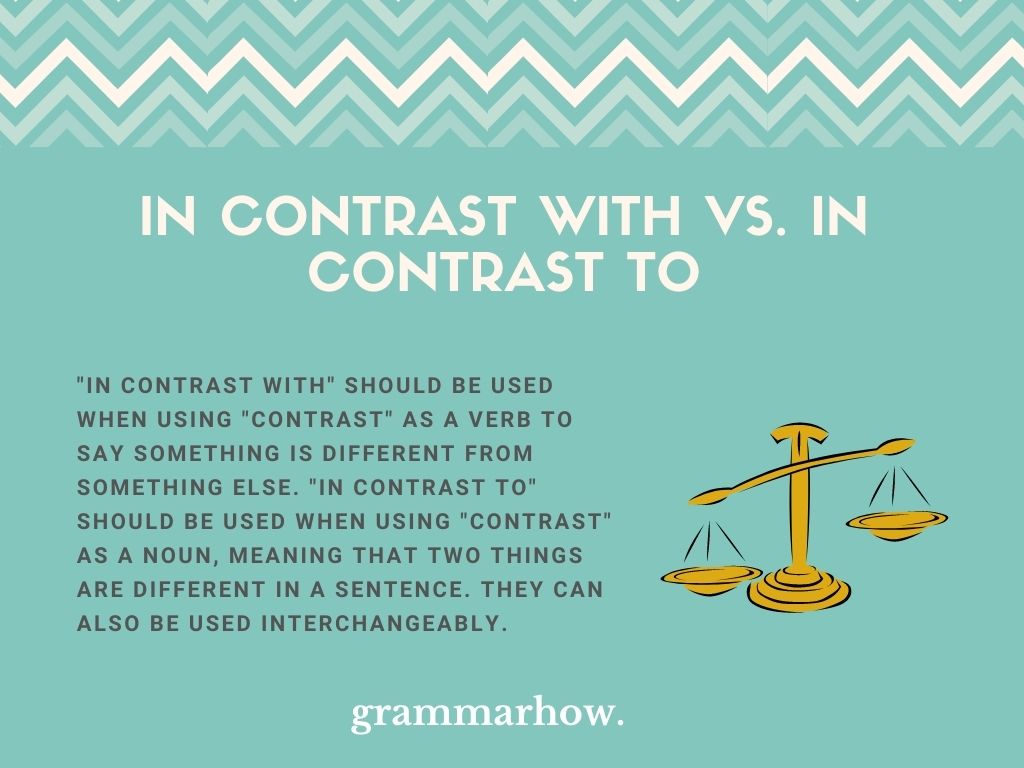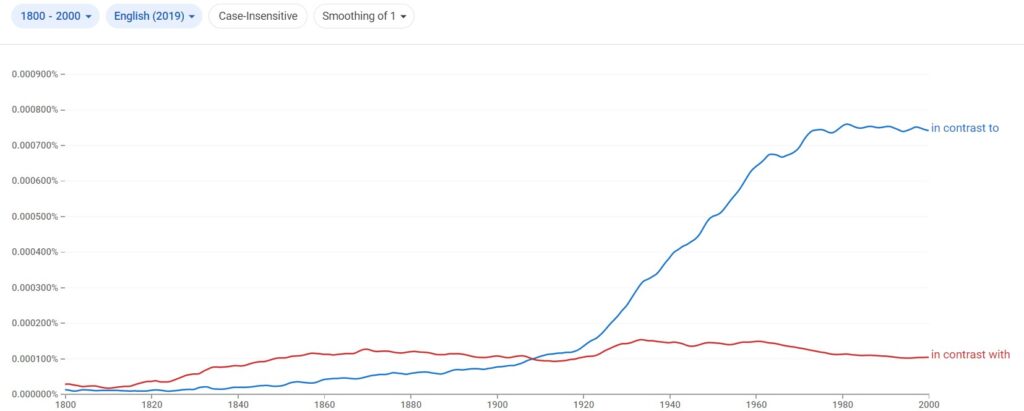While the two phrases in contrast to and in contrast with might look similar, some key differences make themselves known here. We’ll cover them a little more closely so you can see what the prepositions at the end of the words do to the meaning.
What Is The Difference Between “In Contrast With” And “In Contrast To”?
“In contrast with” should be used when using “contrast” as a verb to say something is different from something else. “In contrast to” should be used when using “contrast” as a noun, meaning that two things are different in a sentence. They can also be used interchangeably.

To help with your understanding, The Cambridge Dictionary shows that “contrast” is a noun and means that there is “an obvious difference between two or more things.”
See 12 examples further down in this article.
Do People Prefer “In Contrast With” Or “In Contrast To”?
The two phrases are interchangeable, meaning there will always be one that people prefer over the other. If we don’t look at the original meanings that were explained above and instead look at them in the sense of interchangeable words, is there a clear winner that people prefer?
Yes. If we look at this graph, we can see that while historically “in contrast with” was more popular, around 100 years ago, people started to use “in contrast to” instead. It grew exponentially since then, while “in contrast with” stayed on the same level.

Most of the time, if we’re comparing two or more objects with each other, we’ll be using “in contrast to” to show it. That’s the more popular choice of the two. While we can still use both, it seems that people are put off by including the preposition “with” after the phrase.
This might be because the phrase “in contrast with” sounds a little clunky to the ear. When people use “contrast with,” they typically remove the “in” and split it between a sentence, like so:
- She likes to contrast her wine with some crackers.
See how “her wine” is put between “contrast” and “with.” That’s the most common way “in contrast with” is used in a verb form, and therefore the least common way to use the phrase.
Is It Important To Be Consistent In The Use Of Either “In Contrast With” Or “In Contrast To”?
When writing either one of them, it’s essential to be consistent. Like any language rules or grammatical changes, our writing often becomes more concise and professional when we stick to one.
If we choose to flip between the two forms throughout a piece of writing (whether creative or formal), people will notice the differences. It won’t look good on paper, and it’s best if you can stick to one.
We encourage you to use “in contrast to” since it’s the most popular choice of the two. More people are used to reading it and writing it themselves, making it better received by the general public.
Also, “in contrast to” is a really good phrase to use in formal writing. If you’re writing an essay and want to show two contrasting points (points that obviously differ from each other), you may use “in contrast to” as a conjunction or sentence starter to introduce them in an interesting way. It’s one of the best practices for you to elevate your essay-writing skills.
Examples Using “In Contrast With”
Let’s look through some examples of using “in contrast with” in a sentence. As we’ve mentioned, it’s more common to use it in the verb form when the phase splits up, but we’ll try and use it as written as much as possible so you can decide for yourself whether you think it feels clunky.
- He likes to contrast his outfit with his hat to make himself stand out.
- They work in jeans and jumpers, in contrast with the professional attire of the office.
- We like to contrast our wine with a bit of cheese or some fine cuisine.
- You work hard, in contrast with the majority of the other children in this class.
- He talks to me all the time in contrast with my husband, who never speaks to me.
See how the phrase “in contrast with” can often be replaced to be more to-the-point if we used “in contrast to.” People prefer the way it rolls off the tongue. Try and say these examples aloud and see for yourself if you can see it.
Of course, everyone is different. You may prefer the phrase “In contrast with.” If so, we encourage you to use this instead since language rules like this often come down to individuality just as much as they do grammatical correctness.
Examples Using “In Contrast To”
Let’s look at “in contrast to” now as a noun phrase and see when it’s most appropriate to use.
- My country is poor in contrast to what is said about it in the news.
- In contrast to the point that I made previously, people often order takeout straight to their door.
- My boss said I work hard in contrast to every other worker in the building.
- In contrast to what she brought up, I’d like to remind you that we’re part of a democracy.
- You’ll find that walking in contrast to the flow of traffic is exhilarating!
- Do these jeans look good in contrast to my jacket?
See how we use “in contrast to” in a slightly different manner. It’s also more common to start a sentence with it if we’ve previously established a point in our writing or speaking and want to introduce a contrasting argument.
What Can You Say Instead Of In Contrast With Or To?
There are always options and alternatives to phrases you can use. We’ll look at some of the best ones for “in contrast with” and “in contrast to” to see if you can find something that works a little better for you or the tone you’re trying to convey.
- Contrary to
This is a good sentence starter or way to combine two contrasting points.
- In comparison
Another good way to use “contrast,” without using the word directly.
This one works well in writing more than it does in speaking, but is a suitable alternative nonetheless.
You might also like: “By Contrast” Or “In Contrast” – Difference Explained (Helpful Examples)

Martin holds a Master’s degree in Finance and International Business. He has six years of experience in professional communication with clients, executives, and colleagues. Furthermore, he has teaching experience from Aarhus University. Martin has been featured as an expert in communication and teaching on Forbes and Shopify. Read more about Martin here.
